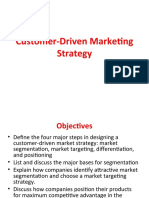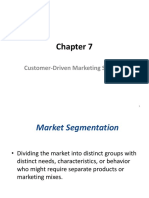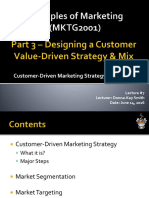0% found this document useful (0 votes)
12 views25 pagesModule 5 - Market Segmentation
The document outlines the market segmentation process, which involves dividing a large market into smaller groups based on common characteristics to effectively target customers. It details various types of segmentation, including geographic, demographic, psychographic, and behavioral, as well as strategies for targeting and positioning products. Additionally, it emphasizes the importance of differentiation in creating a unique brand identity and enhancing customer loyalty.
Uploaded by
mubeenakm99Copyright
© © All Rights Reserved
We take content rights seriously. If you suspect this is your content, claim it here.
Available Formats
Download as PDF, TXT or read online on Scribd
0% found this document useful (0 votes)
12 views25 pagesModule 5 - Market Segmentation
The document outlines the market segmentation process, which involves dividing a large market into smaller groups based on common characteristics to effectively target customers. It details various types of segmentation, including geographic, demographic, psychographic, and behavioral, as well as strategies for targeting and positioning products. Additionally, it emphasizes the importance of differentiation in creating a unique brand identity and enhancing customer loyalty.
Uploaded by
mubeenakm99Copyright
© © All Rights Reserved
We take content rights seriously. If you suspect this is your content, claim it here.
Available Formats
Download as PDF, TXT or read online on Scribd
/ 25






















































































